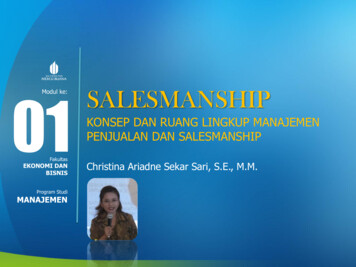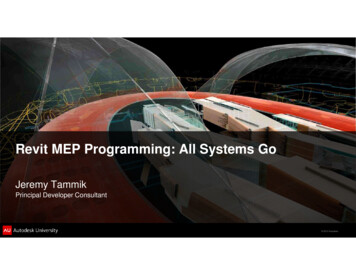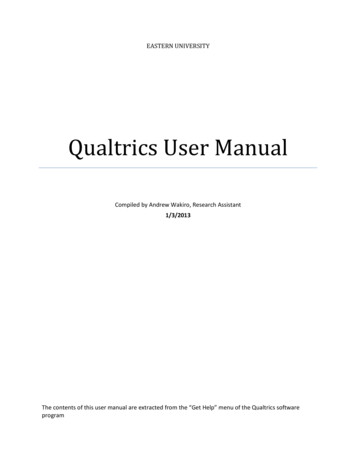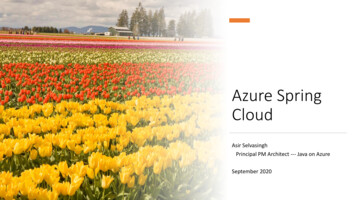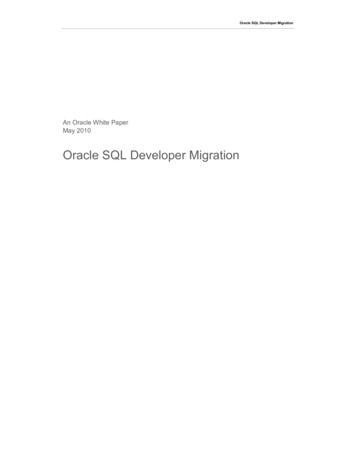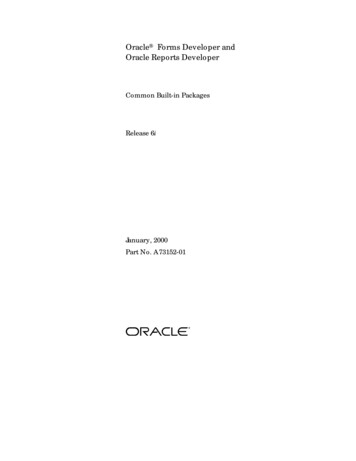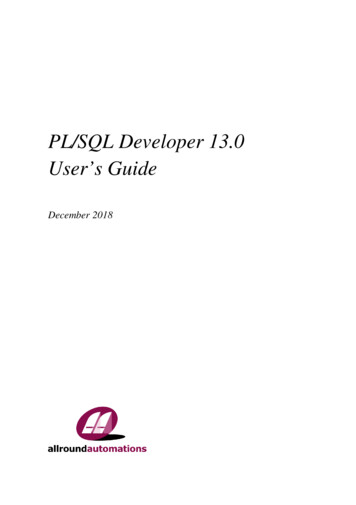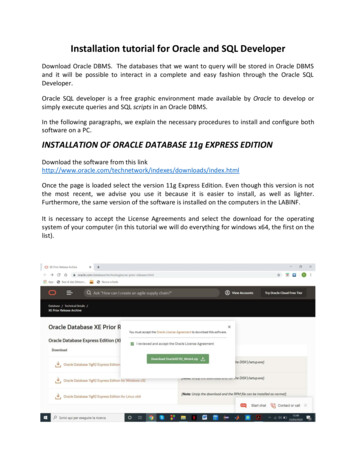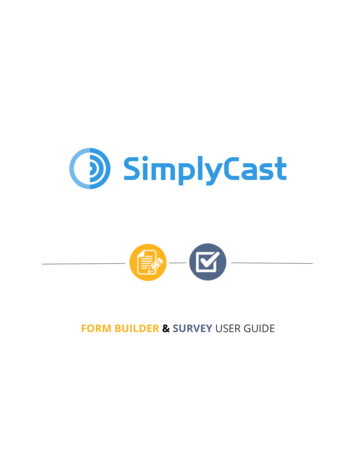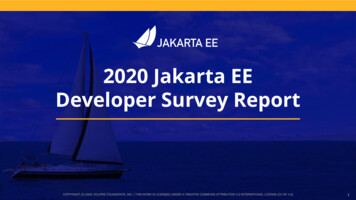
Transcription
2020 Jakarta EEDeveloper Survey Report
Executive Summary Spring/Spring Boot continues to be the leading framework for building cloud nativeapplications, but its share declines 13% (from 57% in 2019 to 44% in 2020). Jakarta EE is emerging as the second place cloud native framework with 35% usage in thisyear’s survey. The popularity of microservices may be waning, with the usage of the microservices architecturefor implementing Java systems in the cloud declining since last year (39% in 2020 vs 43% in 2019). The Jakarta EE community is looking for better support for microservices in the platform. Java/Jakarta EE 8 hits the mainstream with 55% adoption. Despite only shipping in September2019, Jakarta EE 8 usage has skyrocketed to 17%. Use of the monolithic architecture approach for implementing Java systems in the cloud hasdoubled since last year with 25% adoption reported in 2020 (up from 13% in 2019).
IntroductionThe objective of this survey was to help Java ecosystem stakeholders betterunderstand the requirements, priorities, and perceptions of enterprisedeveloper communities and everyone in the Java ecosystem gain a betterunderstanding of how the cloud native world for enterprise Java is unfoldingand what that means for their strategies and businesses. From April 6 to May 5,2020, 2,180 individuals (up from 1,772 in the 2019 survey) participated in thesurvey.The survey was heavily promoted on Jakarta EE Working Group and EclipseFoundation’s various social media channels, the Jakarta EE Working Group andEclipse Foundation websites, newsletters, blogs and through partners, includingJakarta EE Ambassadors, JUG leaders, and Java Champions.
KEY TAKEAWAY1Which Java frameworks are you using for cloud native applications?44%Spring/Spring Boot35%Jakarta EE29%Eclipse MicroprofileQuarkusEclipse Vert.xDropwizardMicronaut16%14%10%6%Spring/Spring Boot’s sharedeclines 13% as the leadingframework for building cloudnative applications (from 57%in 2019 to 44% in 2020).
KEY TAKEAWAY2835%With the delivery of Jakarta EE 8 in September 2019,Jakarta EE starts to fulfill its promise of acceleratingbusiness application development for the cloud,emerging as the second place cloud nativeframework with 35% usage in this year’s survey.
KEY TAKEAWAY3Since its announcement early in 2019,16%the adoption of Quarkus hasskyrocketed with 16% of developersnow using the framework.
KEY TAKEAWAY4What architectural approach do you plan to use forimplementing your Java systems in the ss/FaasOther (please specify)9%4%The popularity of microservicesmay be waning, with the usage ofthe microservices architecturefor implementing Java systemsin the cloud declining since lastyear (39% in 2020 vs 43% in 2019).
KEY TAKEAWAY5What architectural approach do you plan to use forimplementing your Java systems in the cloud?39%25%23%MicroservicesMonolithicHybrid(43% in 2019)(13% in 2019)(20% in 2019)Use of the monolithic architecture approach has doubled since last year. The marketseems to be less interested in re-architecting legacy applications to run as microservices,possibly because CIOs have realized that the fastest way to the cloud is ‘lift and shift’.
KEY TAKEAWAY6The Jakarta EE community is looking for better supportfor microservices in the platform. Combined with thedecline in adoption of Spring Boot and the rise of JakartaEE, the takeaway here may be that developers are looking pastsingle vendor microservices frameworks in favor of vendor-neutralstandards for building Java microservices.
KEY TAKEAWAY7(1 / 2)What version of Java EE/Jakarta EE is yourorganization running in production?38%Java EE 8Java EE 7We don’t run JavaEE in productionJava EE 6Jakarta EE 8Older than Java EE 627%21%20%17%13%Java/Jakarta EE 8 hitsthe mainstream with55% adoption.Despite only shippingin September 2019,Jakarta EE 8 usagehas skyrocketed to17%.
KEY TAKEAWAY7(2 / 2)Driven by the contributions of a diverse global community of dedicateddevelopers and vendors, Jakarta EE 8, the first major Jakarta EErelease by the Eclipse Foundation, has seen explosive growth withmore Compatible Implementations certified as FullPlatform Compatible Products in 8 months than Java EE 8 hasin over 2 years.
KEY TAKEAWAY8Eclipse Che’s adoption hassurged with reported usagegrowing from 4% in 2019 to11% in 2020.4%201911%2020
KEY TAKEAWAY9What version of Java SE is your organization running in production?64%Java 8Java 11Java 728%16%Java 611%Java 1411%Older than Java 610%Java 8 adoption has decreased to 64%(84% in 2019). This is an indicator thatdevelopers are finally moving away fromJava 8 and Java 11 is replacing Java 8 asthe default Java.Java 11 use has surged to 28% (20%in 2019).Java 14 use is sitting at 11%. Java 14uptake may be due to the cloudproviders looking to stay on the latestand greatest
KEY TAKEAWAY10Which container orchestration technologiesare you using for cloud native applications?54%27%22%KubernetesDocker SwarmApache mesos
Demographics
RegionsWhat region are you located in?EuropeNorthAmerica19%37%6%Caribbean &Latin America9%6% MiddleAfricaEast23%AsiaPacific
RolesWhat best describes your itectTeam Leader8%DevelopmentManager or Leader5%C-level
EmployeesHow many employees work in your organization?50%15%Less than 100100-50013%9%8%5%10,000 1,001-5,000501-1,0005,001-10,000
IndustriesWhat industry do you work in?ITSoftwareComputer & ElectronicsManufacturingEducationFinancial ServicesGovernment22%19%13%11%11%5%Retail & ConsumerServicesTelecommunicationsHealthcare ality4%3%3%3%2%1%
Thank you!To receive exclusive access to detailed industry researchfindings, join the Jakarta EE Working Group:Join today!Learn More:Jakarta.eeConnect:@JakartaEE
The popularity of microservices may be waning, with the usage of the microservices architecture for implementing Java systems in the cloud declining since last year (39% in 2020 vs 43% in 2019). The Jakarta EE community is looking for better support for microservices in the platform. Java/Jakarta EE 8 hits the mainstream with 55% adoption.
